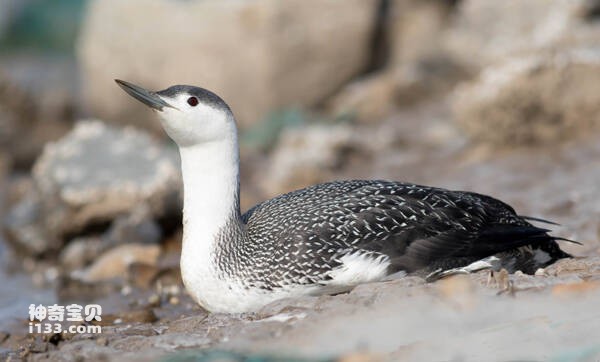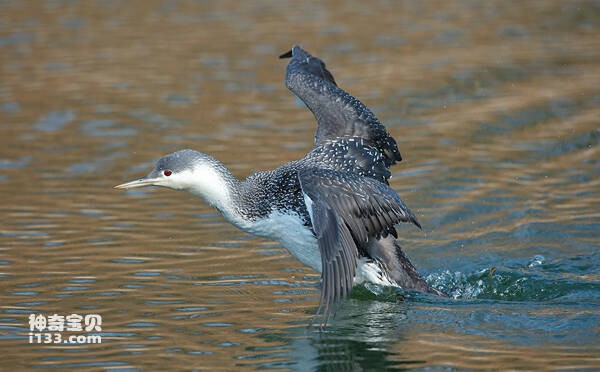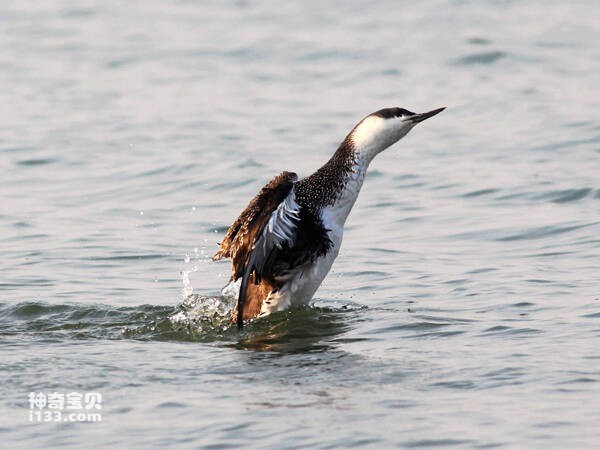Gavia stellata
IUCN
LCBasic Information
Scientific classification
- name:Gavia stellata
- Scientific Name:Gavia stellata,Red-throated Loon,Red-throated Diver
- Outline:Waterfowl
- Family:
Vital signs
- length:56-69CM
- Weight:1.25-2.5kg
- lifetime:No textual research information is available
Feature
The mouth is thin and pointed, slightly upturned, the top of the head, side of the head, throat and neck of the summer feather light gray, the side of the head of the winter feather below the eyes, the side of the neck, neck, throat to the entire lower body white
Distribution and Habitat
The red-throated loon breeds in Arctic or subArctic regions (north of 50° N) from northern Europe and northern Asia to northern North America. Wintering in the Mediterranean Sea, Black Sea, Caspian Sea, Florida, California, Japan and China's Liaodong Peninsula, Guangdong, Fujian, Hainan Island and Taiwan and other coastal areas.
Native distribution: Austria, Azerbaijan, Belgium, Bulgaria, Canada, China, Croatia, Czech Republic, Denmark, Estonia, Faroe Islands, Finland, France, Georgia, Germany, Greece, Greenland, Hungary, Iceland, India, Iran, Ireland, Italy, Japan, Kazakhstan, Korea, Republic of Korea, Latvia, Lithuania, Macedonia, Former Yugoslavia Ruff, Mexico, Moldova, Montenegro, Netherlands, Norway, Pakistan, Poland, Portugal, Romania, Saint Pierre and Miquelon, Serbia, Slovakia, Slovenia, Spain, Svalbard and Jan Mayen, Sweden, Switzerland, Turkey, Turkmenistan, Ukraine, United Kingdom, United States.
Distribution: Algeria, Armenia, Belarus, Bosnia and Herzegovina, Gam
Appearance
The head and neck of the breeding body of red throated loon are light gray, the forehead and the crown of the head have black axial feathers, and the rear neck has black and white longitudinal stripes. The upper body and wings are covered with grayish-black feathers, sometimes with small white markings; The foreneck has a prominent maroon triangular spot, from the lower larynx to the upper thorax; Maroon triangular spot below to the whole lower body white, chest side with black longitudinal lines, two flanks with black markings; Undertail coverts with black markings. The winter feathers are dark brown from the forehead, the crown, the back of the neck to the tail, with small white spots on the back; The side of the head, chin, larynx, front neck and entire lower body are white.
Juveniles are similar to non-breeding feathers, but are darker on the crown and nape, with pale white pinnacles, brown markings on the head and neck, and white spots on the shoulders and upper back.
The ir
Details
The Red-throated Loon (Gavia stellata) is a large waterfowl in the family Gavia Stellata. Some scholars believe that the population of the red-throated loons breeding in Spitsbergen and Bear Island, Norway, is slightly lighter than the named subspecies and has a separate subspecies, G. S. guamata. However, most scholars believe that there is no obvious difference between the two subspecies and do not agree to be divided into two subspecies, so it is still a monotypic species.

The red-throated loon is good at swimming and diving. It swims with its neck stretched very straight and often looks from side to side. It also flies very fast and in a straight line. Taking off is more flexible than other diving ducks, which can fly directly out of the water without running on the surface of the water, so it can also take off in smaller pools, but it is more difficult to walk on the ground, often crawling on the ground.
The red-throated loon feeds mainly on a variety of fish. They also eat crustaceans, mollusks, fish eggs, aquatic insects and other aquatic invertebrates. They hunt fish by diving and swimming fast under the water. Underwater duration can be as long as 60-90 seconds. The red-throated loon makes a gwuk-gwuk-gwuk sound as it flies.

Red-throated loon migrates late in spring, leaving the wintering waters to move to the northern breeding grounds in early to mid-April, and sometimes not migrating to the coast of Fujian, China as late as the end of April. The southern migration in autumn is also late, most of them start from early to mid-October after the breeding ground freezes, and reach the southern wintering ground in late October to November. Most migrations were in pairs or small groups, but some were single migrations.
The red-throated loon breeds in inland lakes, rivers and ponds in the northern Hemisphere. Nest on the ground near the water's edge. In late April and early May, pairs arrive at the breeding grounds as soon as the northern ice melts. The combination of male and female is relatively fixed and usually does not change once it is combined. Breeding period May to August. When mating, male and female birds swim in the water and chase each other by flapping their wings, jumping up from the water from time to time, standing on the water, lowering their heads to their chests, and then extending their heads vertically, constantly singing. Courtship behavior goes on continuously for 2-3 hours at different times of the day. The nest is simple and small, 20-60 cm in diameter. The bottom of the nest is cup-shaped, close to the shore, less than 1 meter from the water. Eggs are laid in late May and early June, with 2 eggs per clutch, and occasionally as few as 1 and as many as 3 eggs. Egg shell is rough, dark olive green, with dark brown spots; The size is 68-82 mm ×43-48 mm, with an average of 73.8 mm ×44.8 mm; It weighs 73-89.7 grams, with an average of 82.7 grams. The male and female birds incubate the eggs in turn, and the incubation period is 24-29 days. Chicks are early sex, the whole body is covered with feathers after hatching, 10-12 hours can swim in the water, and after about 40 days of fledgling life under the lead of the parent bird, they can fly.

The red-throated loon was once common in winter along the southeast coast of China, but was rarely reported in the late 20th century and early 21st century. According to the Asian midwinter waterbird survey organized by the International Waterfowl Research Bureau (IWRB) in 1990 and 1992, 280 waterbirds were seen in China in 1990, and only 17 were seen in 1992, which is quite rare and requires protection. In 2006, Wetlands International estimated the global population of the red-throated loon at 200,000-590,000 individuals. In 2009, estimates of the number of red-throated loon populations in some countries and regions were as follows: less than 50 red-throated loon populations migrated to and overwintered in China, and less than 1,000 red-throated loon populations overwintered in Taiwan; 50-10,000 overwinter in Japan; 10,000-100,000 pairs of adult birds and 1,000-10,000 individuals overwinter in Russia.
The breeding of red-throated diver is threatened by water level fluctuation, water acidification, heavy metal pollution and afforestation in wetland, and it will also abandon the original habitat due to human leisure activities and coastline development. During the winter, red-throated loons are highly vulnerable to coastal oil spills, especially in hot development areas, and are highly sensitive to coastal wind farms. In oceans and great lakes, red-throated loons can become entangled in nearshore fishing nets and drown, which increases the mortality rate of the species. Red-throated loons are also vulnerable to outbreaks of avian influenza viruses.

It has been included in the List of Land Wildlife that are beneficial or of important economic and scientific research value under State Protection issued by the State Forestry Administration of China on August 1, 2000 (Item 1).
It has been included in the "China Red List of Species" (2004), assessment grade - non-threatened species (LC).
It is listed on the IUCN Red List of Threatened Species (IUCN) 2018 ver 3.1 - Species not at Risk (LC).
Protect wild animals and eliminate wild meat.
Maintaining ecological balance is everyone's responsibility!








